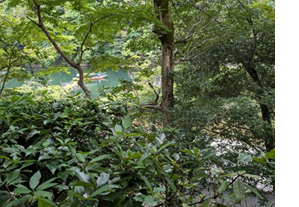Kyoto City’s Implementation of Japan’s Highest Accommodation Tax II Through a Kyoto Guide
Yoshie Doi

Photo taken on 28th September 2024 in Arashiyama
It was more than 10 years ago, but I received a sudden request from the American Embassy to show them around Kyoto. On the morning of the day of the tour, they asked me to show them places that the Emperor and Empress would be happy to visit. The first place I visited was Shusuitei in Kyoto Gyoen.
Shusuitei is the only surviving building of the Kujo family, one of the five regent families. It is said to have been built around 200 years ago in the late Edo period. It is a wonderful spot from which you can see Kujo Pond and Takakura Bridge from the second floor. The sukiya-style shoin-style mansion can be viewed for a 300 yen admission fee. Please note that the building is closed on some days of the week, so please check the website for details. You can also rent the building for half a day or a full day to hold tea ceremonies and lectures.
When I was in charge of training for government tourism officials from overseas, I also showed them around Shusuitei. They seemed to enjoy it so much that they said they didn’t want to leave, and spent a long time there.
I was relieved that we were able to provide guidance that was tailored to my needs, rather than following a set route. In addition to the temples and shrines featured in tourist guidebooks, shopping is also one of the things to enjoy.
Aritsugu’s shop in Nishiki Market (a cutlery shop selling knives, etc.) is visited by many foreigners. When I have guided the proprietresses of inns from all over the country, they always ask me, “I would like to buy a blade for senmaizuke, please tell me where you can buy it.” I will guide you to Aritsugu in Nishiki Market. The colorless vinegar used for senmaizuke is also sold by Murayama zousu (Vinegar shop).
Kyoto brands are popular because there are stores that specialize in professionals and stores that anyone can purchase from. There are also many high-quality products that are unique to Kyoto, and you can purchase products that meet your needs in any field.
Kyoto is a city where you can casually drop in and buy even highly specialized items. Apparently, a visitor from the UK who visits Japan every year purchases a Jizo statue. There was also someone who apparently purchased 100 Shigaraki-yaki raccoon dog statues as souvenirs. I wonder if they were sent by sea to their home country. It’s surprising.
These souvenirs go beyond the realm of common sense, but perhaps a future where Kyoto tourism will also go beyond common sense is waiting for us. In the city, there are also Imperial Gardens and shrines that are not covered in concrete, and nature such as the Kamo River and Katsura River, where you can commune with the heart of the earth.
I think the idea of a lodging tax could go beyond common sense a little and be thought of as something like a donation or a fund to support the homeland of humanity.
Is there an invisible energy in Kyoto that has the effect of healing cells? I think there is both invisible and visible energy, and perhaps Kyoto’s unique feature is that it is overflowing with both types of energy.Its origins lie in the 1,074 years of friendship between the Emperor, who served as the capital, the nobles, and the townspeople, who shared a mutual love and dedication. In gratitude for this history, why not consider a new system, including donations to preserve this atmosphere, as an administrative body?
For example, we believe that the Kyoto Suzume Culture and Tourism Research Institute can help those who make large donations such as “Kokoro no Furusato Nozei” by showing them around carefully selected spaces where they can learn about the soothing spirit of Kyoto, as well as by facilitating interactions with local residents.
The end of document
Translated by Masami Otani
